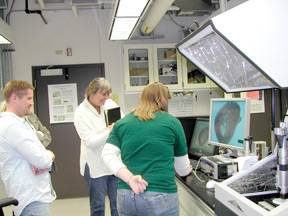Centuries-old Jamestown seeds examined at ARC
 Seeds
four centuries old, found in a well at Jamestown and analyzed in
William and Mary’s Surface Characterization Lab, are sprouting new
clues about the early days of the Jamestown Colony.
Seeds
four centuries old, found in a well at Jamestown and analyzed in
William and Mary’s Surface Characterization Lab, are sprouting new
clues about the early days of the Jamestown Colony.
The seeds recovered from the well at Historic Jamestowne were mainly from food plants native to the area such as berries, cherries, persimmons and grapes. Most intriguing to archaeobotanist Steve Archer are the implications of three tobacco seeds, including one undamaged specimen dating to 1611, preserved by the wet, anaerobic conditions in the well.
Archer, an adjunct instructor in William and Mary’s anthropology department, is employed by the Colonial Williamsburg Foundation. He said undamaged tobacco seeds are a comparatively rare find in archaeological digs and a determination of the species of the lone tobacco seed might reveal evidence of the first known American cultivation of what became Virginia’s first profitable crop.
The wild native tobacco growing in Virginia, Archer said, is Nicotiana rustica, a variety with a much higher nicotine content than the Nicotiana tabacum strain, brought to the James River region from the West Indies by John Rolfe, the colonist who later married Pocahontas. The native rustica tobacco was valuable to the indigenous population, but was too strong and coarse to satisfy the growing cravings of the expanding European market. Rolfe’s imported tabacum variety became not only the basis of his personal fortune, but also the basis of the viability of the Jamestown Colony as well as Virginia’s first important cash crop.
“The question,” Archer said, “is how well developed is the commercial production of the tabacum species in 1611—or are they still playing around with the rustica that grew freely and locally?”
Archer took the tobacco seeds to William and Mary’s Surface Characterization Lab at the Applied Research Center in Newport News where lab manager Amy Wilkerson and her team put the 1611 seed under their HIROX microscope to compare it with a known tabacum seed from the early 20th Century.
“The samples had been preserved in 400-year-old well water they found them in, and we couldn't let them dry out,” Wilkerson said, which she said created a bit of a challenge in creating sharp, high quality magnified images of the seeds, which are about half a millimeter in diameter. Surface characterization comparison proved inconclusive and Archer said that DNA testing may be next for the 1611 seed.
National Geographic magazine is funding the Jamestown archaeobotany study. William Kelso, director of archaeology at Historic Jamestowne for APVA Preservation Virginia, said in a press release issued by National Geographic that the 6-foot-square, 15-foot-deep well, located inside the north corner of the fort, is a virtual time capsule of environmental and cultural data, according to Kelso. When it was no longer used as a water source, the colonists filled it with trash and then built an addition to the governor’s house over it in 1617, sealing everything inside until archaeologists began excavating it in the fall of 2005.
Results of the microscopic analysis will be included in presentations at the Society of Historical Archaeology conference in Williamsburg Jan. 10-14.
 Skip to main content
Skip to main content
